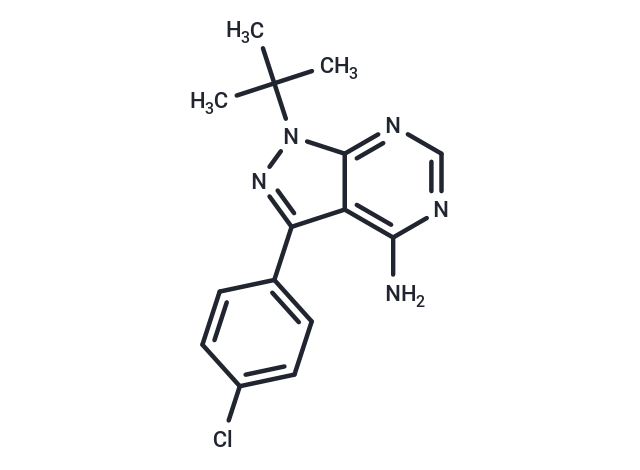购物车
- 全部删除
 您的购物车当前为空
您的购物车当前为空

PP2 (AG 1879,AGL 1879) 是 Lck/Fyn 抑制剂 (IC50:4/5 nM),对 EGFR 的效力降低约 100 倍,对 ZAP-70、PKA 和 JAK2 无活性。


为众多的药物研发团队赋能,
让新药发现更简单!
PP2 (AG 1879,AGL 1879) 是 Lck/Fyn 抑制剂 (IC50:4/5 nM),对 EGFR 的效力降低约 100 倍,对 ZAP-70、PKA 和 JAK2 无活性。
| 规格 | 价格 | 库存 | 数量 |
|---|---|---|---|
| 2 mg | ¥ 313 | 现货 | |
| 5 mg | ¥ 489 | 现货 | |
| 10 mg | ¥ 852 | 现货 | |
| 25 mg | ¥ 1,420 | 现货 | |
| 50 mg | ¥ 2,080 | 现货 | |
| 100 mg | ¥ 3,480 | 现货 | |
| 200 mg | ¥ 4,890 | 现货 | |
| 1 mL x 10 mM (in DMSO) | ¥ 547 | 现货 |
| 产品描述 | PP2 (AG 1879,AGL 1879) is a effective inhibitor of Lck/Fyn (IC50:4/5 nM) , ~100-fold less potent to EGFR, inactive for ZAP-70, PKA and JAK2. |
| 靶点活性 | Fyn:5 nM, Lck:4 nM |
| 体外活性 | 在局灶性脑缺血损伤的大鼠中,PP2()降低约50%梗死面积.在局灶性脑缺血损伤的大鼠中,与对照组相比,PP2(1.5 mg/kg,i.p.)具有更好的神经功能评分.在脾脏接种HT29细胞的SCID小鼠中,与对照组相比,PP2(5 mg/kg/day)降低原代肿瘤的生长率,且明显降低相对肝重和肝转移量. |
| 体内活性 | 1-100 mM PP2剂量依赖性抑制人类结肠癌细胞(SW480,HT29和PMCO1),肝癌细胞(KYN-2,Li7,PLC/PRF/5和HepG2)和乳腺癌细胞(MDA-MB-468,MCF-7,和 BT-474)生长。在NIH3T3 和NIH-RET/PTC3 细胞裂解液中,5 μM PP2可抑制体内RET/PTC1肿瘤蛋白的磷酸化和信号。在转化RET/PTC1的NIH3T3成纤维细胞、携带自发性RET/PTC1重排的两种人类甲状腺乳头状癌细胞系TPC1 和 FB2中,5 μM PP2抑制血清非依赖性的生长。5 μM PP2抑制TPC1细胞I型胶原基质入侵。在HeLa 和 SiHa 细胞中,10 μM PP2下调pSrc-Y416,pEGFR-Y845和-Y1173 表达水平。10 μM PP2可以调节细胞周期停滞,这是通过上调HeLa和SiHa细胞的p21(Cip1) 和 p27(Kip1),及下调HeLa细胞的cyclin A和细胞周期蛋白依赖性激酶-2,-4 (Cdk-2,-4)的表达,和下调SiHa细胞的cyclin B 和 Cdk-2表达实现的。20 μM PP2抑制40-50% HT29 细胞生长,处理1小时,该浓度降低Src活性,并维持抑制35%Src活性达2天。20 μM PP2明显促进大部分癌细胞(HT29, SW480, PMCO1, PLC/PRF/5, KYN-2, Li7, MCF-7和 MDA-MB-468)聚合,该作用有E-钙粘蛋白依赖性。在癌细胞中,20 μM PP2增强E-钙粘蛋白表达,且强促进E-钙粘蛋白与肌动蛋白细胞骨架的关联。在HT29细胞中,20 μM PP2增强α-catenin,β-catenin和 γ-catenin表达,而在PLC/PRF/5 和 MCF-7细胞,α-catenin的总蛋白水平没有改变,但β-catenin 和 γ-catenin水平稍微增长。 |
| 激酶实验 | Immune complex enzyme assays: The acid-treated enolase is diluted 1:20 with 1× PBS before aliquoting 100 mL/well into a Nunc 96-well high protein binding assay plate. Assay wells are then aspirated; blocked with 0.5% bovine serum, 1× PBS for 1 h at 37 ℃;and then washed five times with 300 mL of 1× PBS/well. The source of Lck is either LSTRA cells or Lck expressed in HeLa cells using a vaccinia expression system. FynT is expressed in HeLa cells using the vaccinia system. Cells (12.5× 106/mL) are lysed in lysis buffer (20 mM Tris, pH 8.0, 150 mM NaCl, 0.5% Nonidet P-40, and 23 trypsin inhibitory units/mL aprotinin), and the lysates are clarified by centrifugation at 14,000 cpm for 15 min at 4 ℃ in an Eppendorf tube. The clarified lysates are then incubated with the appropriate anti-kinase antibody at 10 μg/mL for 2 h at 4 ℃. Protein A-Sepharose beads are added to the antibody/lysate mixture at 250 μL/mL and allowed to incubate for 30 min at 4 ℃. The beads are then washed twice in 1 mL of lysis buffer and twice in 1 mL of kinase buffer (25 mM HEPES, 3 mM MnCl2, 5 mM MgCl2, and 100 μM sodium orthovanadate) and resuspended to 50% (w/v) in kinase buffer. Twenty-five microliters of the bead suspension is added to each well of the enolase-coated 96-well high protein binding plate together with an appropriate concentration of compound and [γ-32P]ATP (25 μL/well of a 200 μCi/mL solution in kinase buffer). After incubation for 20 min at 20 ℃, 60 μLl of boiling 2× solubilization buffer containing 10 mM ATP is added to the assay wells to terminate the reactions. Thirty microliters of the samples is removed from the wells, boiled for 5 min, and run on a 7.5% SDS-polyacrylamide gel. The gels are subsequently dried and exposed to Kodak X-AR film. For quantitation, films are scanned using a Molecular Dynamics laser scanner, and the optical density of the major substrate band, enolase p46, is determined.In companion experiments for measuring the activity of compounds against Lck, the assay plate is washed with two wash cycles on a Skatron harvester using 50 mM EDTA, 1 mM ATP. Scintillation fluid (100 μL) is then added to the wells, and 32P incorporation is measured using a micro-β-counter. |
| 细胞实验 | Cell viability is determined using an in vitro toxicology assay kit following the manufacturer's instructions. Cells are seeded in 96-well plates at day 0. Starting at day 1, cells are treated for 2 days with each of a series of increasing concentrations of PP2 (1 μM, 10 μM, and 100 μM). At the end of this period, cell proliferation is evaluated by a colorimetric assay based on the cleavage of 3-(4,5-dimethylthiazol-2-yl)-2,5-diphenyltetrazolium bromide by mitochondria dehydrogenase in viable cells, leading to formazan formation. This experiment is repeated three times with 10 determinations/tested concentration.(Only for Reference) |
| 别名 | AGL 1879, AG 1879 |
| 分子量 | 301.77 |
| 分子式 | C15H16ClN5 |
| CAS No. | 172889-27-9 |
| Smiles | NC1=C2C(=NN(C(C)(C)C)C2=NC=N1)C3=CC=C(Cl)C=C3 |
| 密度 | 1.35 g/cm3 |
| 存储 | Powder: -20°C for 3 years | In solvent: -80°C for 1 year | Shipping with blue ice. | ||||||||||||||||||||||||||||||||||||||||
| 溶解度信息 | DMSO: 56 mg/mL (185.6 mM) Ethanol: 2 mg/mL (6.62 mM) | ||||||||||||||||||||||||||||||||||||||||
溶液配制表 | |||||||||||||||||||||||||||||||||||||||||
| |||||||||||||||||||||||||||||||||||||||||
评论内容